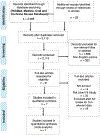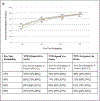A practical, evidence-based, comprehensive (PEC) physical examination for diagnosing pathology of the long head of the biceps
- PMID: 28479256
- PMCID: PMC6427911
- DOI: 10.1016/j.jse.2017.03.002
A practical, evidence-based, comprehensive (PEC) physical examination for diagnosing pathology of the long head of the biceps
Abstract
Background: Clinical examination of the shoulder joint has gained attention as clinicians aim to use an evidence-based examination of the biceps tendon, with the desire for a proper diagnosis while minimizing costly imaging procedures. The purpose of this study is to create a decision tree analysis that enables the development of a clinical algorithm for diagnosing long head of biceps (LHB) pathology.
Methods: A literature review of Level I and II diagnostic studies was conducted to extract characteristics of clinical tests for LHB pathology through a systematic review of PubMed, Medline, Ovid, and Cochrane Review databases. Tests were combined in series and parallel to determine sensitivities and specificities, and positive and negative likelihood ratios were determined for each combination using a subjective pretest probability. The "gold standard" for diagnosis in all included studies was arthroscopy or arthrotomy.
Results: The optimal testing modality was use of the uppercut test combined with the tenderness to palpation of the biceps tendon test. This combination achieved a sensitivity of 88.4% when performed in parallel and a specificity of 93.8% when performed in series. These tests used in combination optimize post-test probability accuracy greater than any single individual test.
Conclusion: Performing the uppercut test and biceps groove tenderness to palpation test together has the highest sensitivity and specificity of known physical examinations maneuvers to aid in the diagnosis of LHB pathology compared with diagnostic arthroscopy (practical, evidence-based, comprehensive examination). A decision tree analysis aides in the practical, evidence-based, comprehensive examination diagnostic accuracy post-testing based on the ordinal scale pretest probability.
Keywords: Biceps tendon; diagnosis; long head; pathology; physical examination; shoulder examination.
Copyright © 2017 Journal of Shoulder and Elbow Surgery Board of Trustees. Published by Elsevier Inc. All rights reserved.
Figures




Similar articles
-
Physical examination tests and imaging studies based on arthroscopic assessment of the long head of biceps tendon are invalid.Knee Surg Sports Traumatol Arthrosc. 2017 Oct;25(10):3229-3236. doi: 10.1007/s00167-015-3862-7. Epub 2015 Nov 26. Knee Surg Sports Traumatol Arthrosc. 2017. PMID: 26611897
-
A concise evidence-based physical examination for diagnosis of acromioclavicular joint pathology: a systematic review.Phys Sportsmed. 2018 Feb;46(1):98-104. doi: 10.1080/00913847.2018.1413920. Epub 2017 Dec 13. Phys Sportsmed. 2018. PMID: 29210329 Free PMC article.
-
Signs and symptoms to determine if a patient presenting in primary care or hospital outpatient settings has COVID-19.Cochrane Database Syst Rev. 2022 May 20;5(5):CD013665. doi: 10.1002/14651858.CD013665.pub3. Cochrane Database Syst Rev. 2022. PMID: 35593186 Free PMC article.
-
Diagnostic tests and algorithms used in the investigation of haematuria: systematic reviews and economic evaluation.Health Technol Assess. 2006 Jun;10(18):iii-iv, xi-259. doi: 10.3310/hta10180. Health Technol Assess. 2006. PMID: 16729917
-
Rapid, point-of-care antigen tests for diagnosis of SARS-CoV-2 infection.Cochrane Database Syst Rev. 2022 Jul 22;7(7):CD013705. doi: 10.1002/14651858.CD013705.pub3. Cochrane Database Syst Rev. 2022. PMID: 35866452 Free PMC article.
Cited by
-
The long head of biceps at the shoulder: a scoping review.BMC Musculoskelet Disord. 2023 Mar 28;24(1):232. doi: 10.1186/s12891-023-06346-5. BMC Musculoskelet Disord. 2023. PMID: 36978047 Free PMC article.
-
MRI findings and clinical testing for preoperative diagnosis of long head of the biceps pathology.J Exp Orthop. 2024 Oct 15;11(4):e70050. doi: 10.1002/jeo2.70050. eCollection 2024 Oct. J Exp Orthop. 2024. PMID: 39415802 Free PMC article.
-
Injuries of the Biceps and Superior Labral Complex in Overhead Athletes.Curr Rev Musculoskelet Med. 2019 Jun;12(2):72-79. doi: 10.1007/s12178-019-09539-5. Curr Rev Musculoskelet Med. 2019. PMID: 30848418 Free PMC article. Review.
-
The "Double Lasso-Loop" Technique Used for Arthroscopic Proximal Biceps Tenodesis.Arthrosc Tech. 2019 Feb 18;8(3):e291-e300. doi: 10.1016/j.eats.2018.11.012. eCollection 2019 Mar. Arthrosc Tech. 2019. PMID: 31016125 Free PMC article.
-
Evaluation of Resident Palpation Skills in Foot and Ankle Anatomic Structures Using Bedside Ultrasound.HCA Healthc J Med. 2020 Jun 27;1(3):161-167. doi: 10.36518/2689-0216.1029. eCollection 2020. HCA Healthc J Med. 2020. PMID: 37424710 Free PMC article.
References
-
- Bennett WF. Specificity of the Speed’s test: arthroscopic technique for evaluating the biceps tendon at the level of the bicipital groove. Arthroscopy 1998;14:789–96. - PubMed
Publication types
MeSH terms
Grants and funding
LinkOut - more resources
Full Text Sources
Other Literature Sources
Medical

